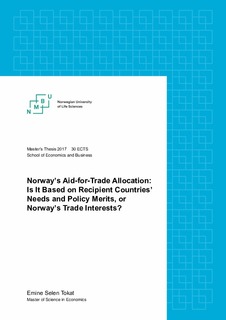| dc.contributor.advisor | Garcia, Roberto J. | |
| dc.contributor.advisor | Aurland-Bredesen, Kine J. | |
| dc.contributor.author | Tokat, Emine Selen | |
| dc.date.accessioned | 2017-09-27T08:06:08Z | |
| dc.date.available | 2017-09-27T08:06:08Z | |
| dc.date.issued | 2017 | |
| dc.identifier.uri | http://hdl.handle.net/11250/2456952 | |
| dc.description.abstract | Facilitating trade has been suggested as a tool for the economic development in poorer countries. However, developing countries are still struggling to integrate into world trade. The purpose of aid-for-trade is to improve the interests and access of developing countries to international markets. The previous literature on the provision of general aid suggests that aid is most effective when allocated while taking into consideration the recipient’s needs as well as merits of the recipient based on the quality of its policies.
This thesis examines whether recipients’ needs, the quality of recipients’ policies, or the donor’s own export interests explain the allocation of aid-for-trade funds in the case of Norway. A panel data set of 113 recipient countries during 2005-2014 is analyzed by estimating a fixed effects model, a random effects model, and a Tobit model. In addition, the data set is used to perform qualitative analysis that groups recipients into aid-recipient types according to high/low per capita GDP, good/poor implementation and enforcement of the rule of law, voice and accountability, and trade openness.
The results show that the motivations suggested in the literature that explain the allocation of general aid do not explain Norway’s allocation of aid-for-trade funds. Only democracy and human rights is a statistically significant factor in affecting allocation decisions. Supplementary qualitative analysis showed that democracy and human rights levels are more important in decision-making when the recipients being considered are those with relatively higher per capita income levels. The estimation results provide no compelling evidence to suggest that Norway systematically allocated aid-for-trade by considering the per capita income level of recipients. Nevertheless, relatively poorer recipients seem to be prioritized for aid allocation by Norway based on average values of the aid provided. Moreover, there is no consistent evidence found that aid-for-trade is allocated by taking into account the level of institutional quality and the degree of trade openness. Finally, there is also no evidence found that Norway pursues its economic interests while allocating aid. Further research should be undertaken to provide more insight into the decision-making process for the allocation of aid-for-trade funds and to understand how the motivations might work differently to the decision-making that governs the allocation of general aid. | nb_NO |
| dc.language.iso | eng | nb_NO |
| dc.publisher | Norwegian University of Life Sciences, Ås | nb_NO |
| dc.rights | Attribution-NonCommercial-NoDerivatives 4.0 Internasjonal | * |
| dc.rights.uri | http://creativecommons.org/licenses/by-nc-nd/4.0/deed.no | * |
| dc.subject | Norway | nb_NO |
| dc.subject | Aid-for-trade | nb_NO |
| dc.title | Norway’s aid-for-trade allocation : is it based on recipient countries’ needs and policy merits, or Norway’s trade interests? | nb_NO |
| dc.type | Master thesis | nb_NO |
| dc.source.pagenumber | 65 | nb_NO |
| dc.description.localcode | M-ECON | nb_NO |

